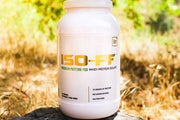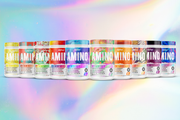
In a previous blog post, we talked about macronutrients (macros), what they are, and how to calculate your macros based upon your goals.
Today we're going to take a look at an incredibly important macronutrient: protein.
Since you're reading our blog, I'm going to assume you know the basics of protein. You probably know that protein is essential to building and maintaining lean muscle mass, and that if you aren’t eating enough, your results will be sub-optimal.
But what you may not know is that eating the right amount of protein will greatly enhance athletic recovery from hard training sessions.
Furthermore, adequate protein intake is critical to supporting optimal weight loss. It may sound counter-intuitive, but eating more protein may be the missing link to you being able to get and stay lean.
So, what makes protein so important?
It's All About Amino Acids
Why is dietary protein is so important? Because it is where you acquire the amino acids your body needs to build and maintain important tissues.We are literally made of protein, from our bones to our muscles, arteries and veins, skin, hair, and fingernails. Our heart, brain, liver, kidneys, and lungs are built of tissue made of protein.
A protein molecule is a molecule made of amino acids bound together. There are 20 amino acids that make up protein molecules. Ten of these amino acids are non-essential, meaning the body can manufacture them on its own, while the other 10 are essential amino acids, meaning the body must acquire them through the foods that you eat.
You may have heard the term “a complete protein" - this refers to a food that contains all of the essential amino acids that your body needs.
Here's a list of common complete proteins:
- Meat (Beef, Pork, Lamb, etc.)
- Poultry
- Fish/Shellfish
- Eggs
- Dairy Foods (Whey Protein)
- Soy Foods
- Quinoa
Here's a list of common incomplete proteins:
- Legumes
- Grains
- Nuts/Nut Butters
- Seeds/Seed Butters
- Vegetables
We must consume complete proteins in order to get the essential amino acids that we need to build and repair our lean tissues which are made out of protein (you can also combine foods that together contain all of the essential amino acids that you need to form a complete protein, this is something that vegetarians need to understand, but that omnivores need not worry about).
We have established that protein is essential in order to get the amino acids that we need to build and repair lean tissue, but why do active, hard-training people need more than sedentary people?
The more physically active that you are, the more that your body breaks down your lean tissue in an effort to put amino acts into your blood stream to then be used by the body (this is what people are generally talking about when they use the term catabolic).
The more active you are, the more your body's demand for amino acids goes up. So the more active that you are, the more your dietary protein retirement will go up in order to meet your bodies demand.
Remember, if there is a deficit in supply of amino acids from protein to your body, your body will make up for it by breaking down your lean tissue.
This inadequate protein intake and subsequent lean tissue breakdown is what can lead to poor recovery, excessive soreness, lack of energy, poor performance, lack of muscle growth, and more.
It is imperative, then, that you ensure adequate protein intake for your activity level.
If you don’t know what percentage of your calories should come from protein, please refer to the last blog post Making Sense of Macros where I'll help you calculate your macros specific to your individual goal.
Protein To Get Lean and Stay Lean
All foods that you consume (natural foods, that is) are comprised of protein, carbs, or fats. Each of these macronutrients cost a certain number of calories to digest. This caloric cost is called the thermic effect of food, or TEF.
The TEF for each of the macronutrients is listed below:
- Protein: 20 to 35%
- Carbs: 5 to 15%
- Fats: 0 to 5%
As you can see, up to 35 percent of the caloric content of protein is spent digesting the protein, while carbs and fats are significantly lower.
This means that if you eat a 2,000 calorie diet with 40 percent of calories coming from protein, you would burn up to 280 calories per day simply digesting the protein.
Compare that to only 140 calories per day burned from a 2,000 calorie diet comprised of 20 percent protein.
When replacing protein with either carbs or fats, the TEF (thermic effect) of food is reduced and asa result is is the amount of calories you burn daily.
In short, increasing your protein levels while restricting your calories will allow for maximum TEF, and therefore, maximum fat loss.
The Take-Home
If you've been suffering from poor recovery, lack of results in the gym, or not seeing the fat loss you want, the answer may be simply upping your protein intake.
If you find it difficult to get enough protein through whole foods each day, a high quality protein supplement, like ISO-PF is a perfect solution.
If you haven’t tried ISO-PF, I can tell you that the flavors are absolutely amazing. Pick up a container today and use promo code BAKEOFF for 20% off (valid until 5/3/18 11:59 PM MT)!
The next blog post will be a Protein Q & A. Ask any protein related questions that you have and I will answer them next week!
-Jerry Teixeira








1 comment
Muchas gracias. ?Como puedo iniciar sesion?
Leave a comment